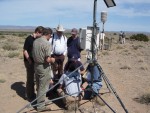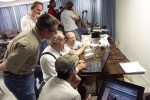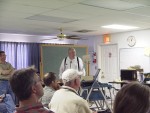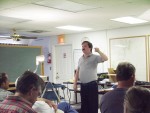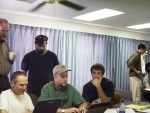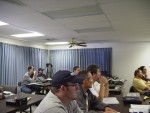Wireless technologies are becoming increasingly important to network infrastrucre at biological field stations.In May 2002, two wireless sensor network workshops were held at the Sevilleta Research Field Station in central New Mexico.The workshops were supported through a Research Coordination Network project, the Resource Discovery Initiative for Field Stations, funded by the National Science Foundation. These workshops ran three days each, and were facilitated by wireless communication experts Dave Hughes and Tom Williams. Each workshop consisted of 23 attendees representing more than 40 biological field stations and LTER sites. The workshops provided hands-on experience setting up wireless sensor networks so participants could set up their own wireless sensor networks.
Wireless networks tend to be cost effective and allow instrumentation of difficult-to-access places. Topics covered at the workshops included wireless local area networks (WLAN’s), wireless network architecture, antennas, radio transmitters, receivers, power issues, wireless communication standards & protocols, FCC guidelines & limitations, and the underlying theories and principles that allow these systems to operate. The instructors used a tag team approach, trading off between real world examples, anecdotes, theoretical perspectives, and hands-on sessions aimed at testing participants’ practical understanding of how these wireless networks can be constructed. Sessions were informal, encouraging questions, comments, and discussion.
These workshops instigated a number of projects incorporating wireless systems in the field.For example, at the Kellogg Biological Station, Tim Bergsma and others will be using Campbell Scientific’s RF400 (900Mhz spread spectrum) radios, powered by solar panels, to relay weather station data from the field to the station where it is posted on the Web.
Ryan Kelsey reports that Black Rock Forest in New York has been testing 802.11 (an IEEE specification allowing for wireless transmission as an unlicensed use of the 2.4 GHz band) wireless solutions for its current remote stations and plans to continue expanding their capabilities.
Konza Prairie LTER included wireless infrastructure in their ClimDB/HydroDB supplement proposal, which has been approved with enough funding to create a wireless cloud at Konza and to connect 1 stream station via 802.11b specifications.
The Center for Environmental Studies / Central Arizona - Phoenix LTER has discussed the possibility of installing a wireless ‘alarm’ system that would be triggered by rainfall events and would then relay a message via phone and/or e-mail to the technicians on-call to visit sites for sample collection. John Anderson at the Jornada LTER will install a wireless setup at a remote weir site, using Campbell Scientific’s RF400 spread spectrum radio, later this fall.
At the Kemp Natural Resources Station in northern Wisconsin workshop participants are creating a wireless network cloud for the station and are installing two sets of wireless monitoring equipment. One will be a micro-meteorological station that will measure a host of weather parameters in old-growth forest. The second installation will be a wireless submersible sonde that will monitor the condition of Tomahawk Lake. Their ultimate goal is to publish the information to the Web, making the data available both to remotely-located researchers and local grade schools.
Don Hockaday reports that the University of Texas Coastal Studies Laboratory has included wireless applications in an appropriation request for intensive studies on watershead impacts on a subtropical lagoon system. They have also submitted a section to build a wireless cloud over some 2,000 square miles of south Texas for data collection and relays.
The El Verde Field Station in Puerto Rico has been downloading weather data from the weather stations directly to the lab using a radio connection for a while, thanks to Dave Hughes initial grant to use wireless communications in scientific projects. Alonso Ramirez reports that they are also working on installing a WLAN at El Verde Field Station and another at the Institute for Tropical Ecosystem Studies.
The LTER Network Office has loaned out 802.11b and FreeWave wireless units for testing at Niwot Ridge LTER, for wireless data transmission around the site. Coweeta LTER is considering using wireless data transmission for the WebCam NET supplied to them as part of the Schoolyard LTER effort.
Dr. Ortiz reports that the Inter American University Bayamon Campus is working right know with a wireless project to collect data from dataloggers in the field (via 900 Mhz radios) and send them wirelessly to the office of the Project Director to post on the web for researchers and students. Also, at the Mata de Platano Field Station, a 900 Mhz radio is being implemented for transmitting weather data from the Rain Wise station to a PC at the Field station that will be accessible remotely via modem, so that data can be retrieved and published on their web server. The university continues to expand their WAN, having over 12 access points throughout the campus.
Workshop Participants
Sensor Workshop Group 1
|
Name
|
Affiliation
|
E-Mail
|
|
Caire, Bill |
Univ. of Central Oklahoma |
|
|
Gosz, Jim |
University of New Mexico |
|
|
Halm, Ian |
HBEF |
|
|
Hamel, Benoit |
McGill University, Montreal |
|
|
Huey, Greg |
Archbold Biological Station |
|
|
Jefferson, Jeff |
University of South Carolina |
|
|
Laundre, James |
Woods Hole, MA |
|
|
Lethaby, Paul |
BBSR |
|
|
McCollum, Bob |
Coweeta Hydrologic Lab |
|
|
McGuiness, John |
E. N. Huyck Preserve |
|
|
McKissack, Travis |
Savannah, GA |
|
|
Moore, Douglas |
University of New Mexico |
|
|
Nylen, Thomas |
Portland State University |
|
|
Ortiz, Eduardo |
Inter American University, P.R. |
|
|
Paton, Steven |
STRI, Unit 0948, APO AA |
|
|
Patram, Kevin |
P.O. Box 2057 Lake Placid, FL |
|
|
Porter, Wayne |
CES, Tempe, AZ 85287-3211 |
|
|
Prach, Raymond |
21 County Road 202, Oxford, MS |
|
|
Ramirez, Alonso |
ITES San Juan P.R. 00931 |
|
|
Schenck, Don |
University of Montana |
|
|
Vande Castle, John |
University of New Mexico |
|
|
Woiak, Sandy |
2700 Scrub Jay Trail, FL |
|
|
Young, Rebecca |
416 Waverley St. #4, CA |
Sensor Workshop – Group 2
|
Name |
Affiliation |
E-Mail
|
|
Michener, William |
University of New Mexico |
|
|
Gage, H. Stuart |
Michigan State University |
|
|
Bryant, Pablo J. |
San Diego State University |
|
|
Bergsma, Timothy |
Kellogg Biological Station |
|
|
Shore, Greg |
LTER Network Office |
|
|
Brock, Brent |
Kansas State University |
|
|
Kelsey, Ryan |
Columbia University, NY |
|
|
Smith, Philip |
Virginia Coast Reserve |
|
|
Waddell, Shane |
UC Davis |
|
|
Bierlmaier, Fred |
H.J. Andrews Experimental Forest |
|
|
Adams, Bryan |
Trinity College, CT |
|
|
Piatt, Joe |
Greene Field Station |
|
|
McHale, Patrick |
SUNY-ESF, NY |
|
|
Smith, David |
USDA/ARS, Fort Collins, CO |
|
|
Wallace, Aaron |
Berkeley, CA |
|
|
Wehrspann, Mark |
Iowa Lakeside Laboratory |
|
|
Couzin, Iain |
Princeton University |
|
|
Steele, Tom |
Kemp Natural Resources Station |
|
|
Boose, Emery |
Harvard Forest, MA |
|
|
Davis, Wendy |
University of Alaska-Fairbanks |
|
|
Losleben, Mark |
Mountain Research Station, CO |
|
|
Anderson, John |
New Mexico State Univiersity |
|
|
Hockaday, Don |
University of Texas-Pan American |
For more about these systems, please contact one of the workshop participants listed or contact Dave Hughes (dave@oldcolo.com) or Tom Williams (tomw@oldcolo.com)

 Enlarge this image
Enlarge this image